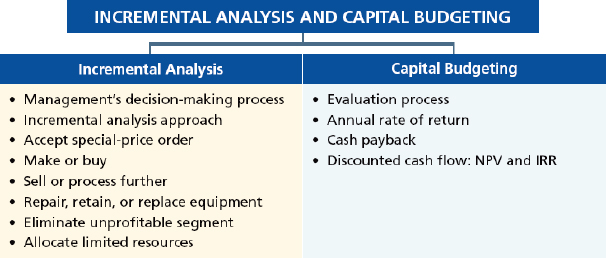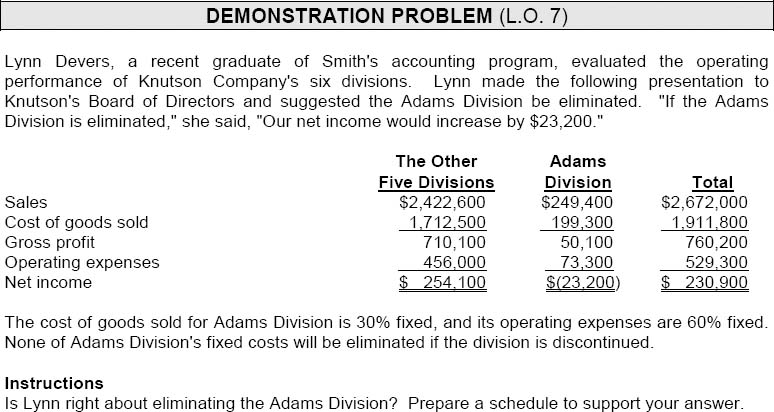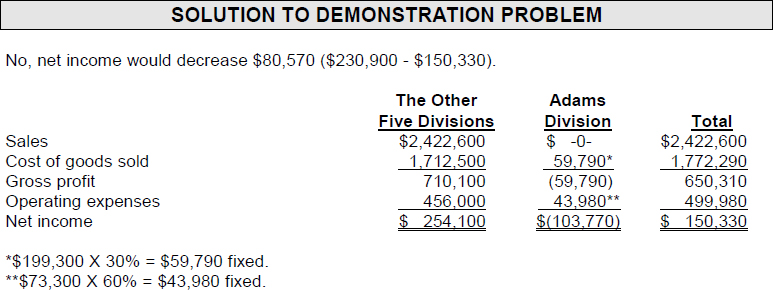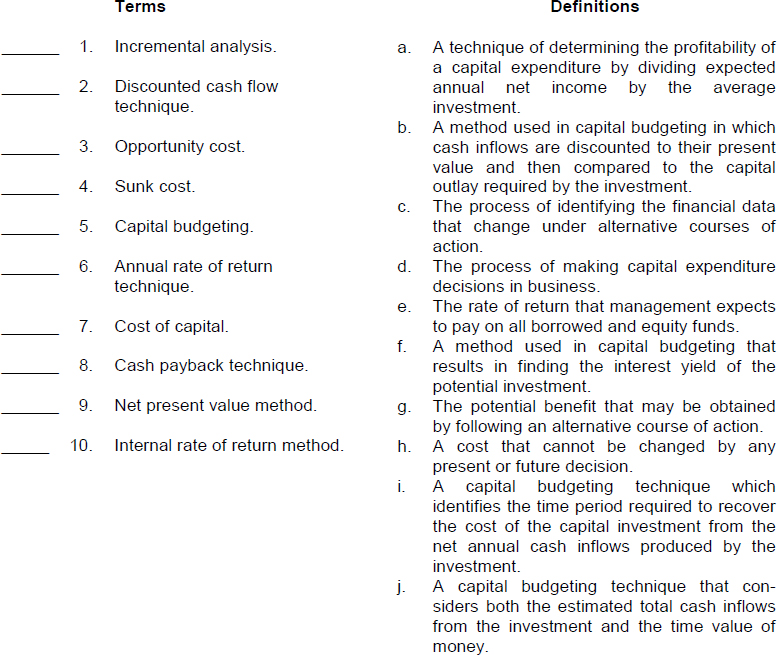Chapter 26
INCREMENTAL ANALYSIS AND CAPITAL BUDGETING
CHAPTER LEARNING OBJECTIVES
After studying this chapter, you should be able to:
- Identify the steps in management's decision-making process.
- Describe the concept of incremental analysis.
- Identify the relevant costs in accepting an order at a special price.
- Identify the relevant costs in a make-or-buy decision.
- Identify the relevant costs in determining whether to sell or process materials further.
- Identify the relevant costs to be considered in repairing, retaining, or replacing equipment.
- Identify the relevant costs in deciding whether to eliminate an unprofitable segment or product.
- Determine which products to make and sell when resources are limited.
- Contrast annual rate of return and cash payback in capital budgeting.
- Distinguish between the net present value and internal rate of return methods.
![]()
PREVIEW OF CHAPTER 26
An important purpose of management accounting is to provide management with relevant information for decision making. This chapter begins with an explanation of management's decision-making process. It then considers the topics of incremental analysis and capital budgeting. The organization and content of this chapter are as follows:

![]()
Management's Decision-Making Process
- (L.O. 1) Management's decision-making process frequently involves the following steps:
- Identify the problem and assign responsibility.
- Determine and evaluate possible courses of action.
- Make a decision.
- Review the results of the decision.
Accounting's contribution to the decision-making process occurs primarily in steps (b) and (d).
Incremental Analysis
2. (L.O. 2) Business decisions involve a choice among alternative courses of action. In making such decisions, management ordinarily considers both financial and nonfinancial information. The process used to identify the financial data that change under alternative courses of action is called incremental analysis.
a. Incremental analysis involves not only identifying relevant revenues and costs, but also determining the probable effects of the decision on future earnings.
b. Data for incremental analysis involves estimates and uncertainty.
c. Gathering data may involve market analysts, engineers, and accountants.
3. In incremental analysis, both costs and revenues may change. However, in some cases (1) variable costs may not change under the alternative courses of action, and (2) fixed costs may change.
Accept an Order at a Special Price
4. (L.O. 3) An order at a special price should be accepted when the incremental revenue from the order exceeds the incremental costs.
a. It is assumed that sales in other markets will not be affected by the special order.
b. If the units can be produced within existing plant capacity, generally only variable costs will be affected.
Make or Buy
5. (L.O. 4) In a make or buy decision, management must determine the costs which are different under the two alternatives. If there is an opportunity to use the productive capacity for another purpose, opportunity cost should be considered. Opportunity cost is the potential benefit that may be obtained by following an alternative course of action. This cost is an additional cost of making the component.
Sell or Process Further
6. (L.O. 5) The basic decision rule in a sell or process further decision is: Process further as long as the incremental revenue from such processing exceeds the incremental processing costs. Incremental revenue is the increase in sales which results from processing the product further.
Repair, Retain or Replace Equipment
7. (L.O. 6) In a decision to repair, retain or replace equipment, management compares the costs which are affected by the alternatives. Generally, these are variable manufacturing costs, the cost to repair, and/or the cost of the new equipment.
a. The book value of the old machine is a sunk cost which does not affect the decision. A sunk cost is a cost that cannot be changed by any present or future decision.
b. However, any trade-in allowance or cash disposal value of the existing asset must be considered.
Eliminate an Unprofitable Segment or Product
8. (L.O. 7) In deciding whether to eliminate an unprofitable segment or product, management should choose the alternative which results in the highest net income. Often fixed costs allocated to the unprofitable segment or product must be absorbed by the other segments or products. It is possible, therefore, for net income to decrease when what appears to be an unprofitable segment or product is eliminated.
Allocate Limited Resources
9. (L.O. 8) When a company has limited resources (floor space, raw materials, or machine hours), management must decide which products to make and sell. In an allocation of limited resources decision, it is necessary to find the contribution margin per unit of limited resource.
a. This is obtained by dividing the contribution margin per unit of each product by the number of units of the limited resource required for each product. For example, if the unit contribution margin for a product is $6 and three machine hours are required, the contribution margin per unit of limited resource is $2 ($6 ÷ 3).
b. Production should be geared to the product with the highest contribution margin per unit of limited resource.
Capital Budgeting
10. (L.O. 9) The process of making capital expenditure decisions is known as capital budgeting. The three most commonly used capital budgeting techniques are (a) annual rate of return, (b) cash payback, and (c) discounted cash flow.
Annual Rate of Return
11. The annual rate of return technique is based on accounting data. It indicates the profitability of a capital expenditure. The formula is:

12. A project is considered acceptable if its rate of return is greater than management's minimum rate of return.
a. The required rate of return is based on the company's cost of capital, which is the rate of return management expects to pay on all borrowed and equity funds.
b. When choosing among several acceptable projects, the higher the annual rate of return, the more attractive the investment.
c. This technique is simple and familiar, but it does not consider the time value of money.
Cash Payback
13. The cash payback technique identifies the time period required to recover the cost of the capital investment from the net annual cash inflow produced by the investment. The formula for computing the cash payback period is:
Cost of Capital Investment ÷ Net Annual Cash Inflow = Cash Payback Period
Annual or net cash inflow is approximated by adding back depreciation expense to net income.
14. The evaluation of the payback period is often related to the expected useful life of the asset.
a. With this technique, the shorter the payback period, the more attractive the investment.
b. This technique is useful as an initial screening tool.
c. This technique ignores both the expected profitability of the investment and the time value of money.
Discounted Cash Flow
15. (L.O. 10) The discounted cash flow technique is generally recognized as the best conceptual approach to making capital budgeting decisions. This technique considers both the estimated total cash inflows and the time value of money. Two methods are used with the discounted cash flow technique: net present value and internal rate of return.
Net Present Value Method
16. Under the net present value method, cash inflows are discounted to their present value and then compared with the capital outlay required by the investment. The difference between these two amounts is the net present value (NPV).
a. The interest rate used in discounting the future cash inflows is the required minimum rate of return.
b. A proposal is acceptable when NPV is zero or positive.
c. The higher the positive NPV, the more attractive the investment.
17. When there are equal annual cash inflows, the table showing the present value of an annuity of 1 can be used in determining present value. When there are unequal annual cash inflows, the table showing the present value of a single future amount must be used in determining present value.
Internal Rate of Return Method
18. The internal rate of return method results in finding the interest yield of the potential investment. This is the interest rate that will cause the present value of the proposed capital expenditure to equal the present value of the expected annual cash inflows. Determining the true interest rate involves two steps:
a. An internal rate of return factor is computed by dividing the capital investment by the annual cash inflows.
b. The factor is then used with the annuity of 1 table to find the approximate internal rate of return.
19. The decision rule is: Accept the project when the internal rate of return is equal to or greater than the required rate of return, and reject the project when the internal rate of return is less than the required rate.
20. In practice, the internal rate of return and cash payback methods are most widely used.
![]()

![]()

REVIEW QUESTIONS AND EXERCISES
TRUE—FALSE
Indicate whether each of the following is true (T) or false (F) in the space provided.
![]()
Circle the letter that best answers each of the following statements.
- (L.O. 2) A number of different types of decisions may be made by management that involve incremental analysis. Which of the following types of decisions do not involve incremental analysis?
- Retain or replace equipment.
- Make or buy.
- Allocation of limited resources.
- All of the above are considered to involve incremental analysis.
- (L.O. 3) It costs Crabbe Company $26 per unit ($18 variable and $8 fixed) to produce their product, which normally sells for $38 per unit. A foreign wholesaler offers to purchase 2,000 units at $21 each. Crabbe would incur special shipping costs of $2 per unit if the order were accepted. Crabbe has sufficient unused capacity to produce the 2,000 units. If the special order is accepted, what will be the effect on net income?
- $2,000 decrease.
- $2,000 increase.
- $6,000 increase.
- $36,000 increase.
- (L.O. 3) Its costs Pineda Company $38 per unit ($25 variable and $13 fixed) to produce its product, which normally sells for $52 per unit. A foreign wholesaler offers to purchase 4,000 units at $30 each. Pineda would incur special shipping costs of $4 per unit if the order were accepted. Pineda has sufficient unused capacity to produce the 4,000 units. If the special order is accepted, what will be the effect on net income?
- $4,000 increase.
- $2,000 decrease.
- $4,000 decrease.
- $8,000 decrease.
- (L.O. 3) Geis Company produces 40,000 printers per month, which is 80% of plant capacity. Variable manufacturing costs are $80 per unit, and fixed manufacturing costs are $1,200,000, or $30 per unit. The printers are normally sold directly to retailers at $150 each. Geis has an offer from a foreign wholesaler to purchase an additional 4,000 printers at $100 per unit. Acceptance of the offer would not affect normal sales of the product, and the additional units can be manufactured without increasing plant capacity. What is the amount of increase (decrease) to net income if Geis accepts the order?
- ($200,000)
- ($ 40,000)
- $ 40,000
- $ 80,000
- (L.O. 4) Which of the following would generally not affect a make or buy decision?
- Selling expenses.
- Direct labor.
- Variable manufacturing costs.
- Opportunity cost.
- (L.O. 4) Opportunity cost is:
- the total difference in costs for two alternatives.
- the potential benefit that may be obtained by following an alternative course of action.
- a cost that cannot be changed by any present or future decision.
- the annual cash inflow from a capital investment.
- (L.O. 4) McAlister Corporation incurs the following annual costs in producing 30,000 floppy drives for computers:

However, if McAlister purchases the floppy drives from another company at a price of $10, what is the increase (decrease) in net income for McAlister?
- ($90,000)
- ($60,000)
- $30,000
- $60,000
- (L.O. 5) Which of the following would generally not affect a sell or process further decision?
- Sales.
- Direct materials.
- Direct labor.
- Fixed manufacturing overhead.
- (L.O. 6) A cost that cannot be changed by any present or future decision is a (an)
- incremental cost.
- opportunity cost.
- sunk cost.
- variable cost.
- (L.O. 7) If an unprofitable segment is eliminated:
- it is impossible for net income to decrease.
- fixed expenses allocated to the eliminated segment will be eliminated.
- variable expenses of the eliminated segment will be eliminated.
- it is impossible for net income to increase.
- (L.O. 7) Many decisions involving incremental analysis have important qualitative features that, while not easily measured, should not be ignored. Which of the following is a qualitative factor that is not easily measured?
- Rent expense.
- Lost morale amongst employees when a line of business is eliminated.
- Increased direct labor costs.
- The opportunity to use productive capacity in some other manner.
- (L.O. 8) In the Rossetto Company, contribution margin per unit is $6 for Product X and $10 for Product Y. Product X requires 4 machine hours and Product Y requires 8 machine hours. What is the contribution margin per unit of limited resource for each product?

- (L.O. 9) Which of the following is incorrect?
- Capital budgeting is the process of making capital expenditure decisions.
- Capital budgeting decisions are the opposite of incremental analysis.
- Accounting data are indispensable in capital budgeting decisions.
- Capital budgeting involves the allocation of limited resources.
- (L.O. 9) The formula for the annual rate of return technique is:
- Annual Cash Flow ÷ Cost of Capital Investment.
- Annual Cash Flow ÷ Average Investment.
- Expected Annual Net Income ÷ Cost of Capital Investment.
- Expected Annual Net Income ÷ Average Investment.
- (L.O. 9) Ehrlich Company had an investment which cost $260,000 and had a salvage value at the end of its useful life of zero. If Ehrlich's expected annual net income is $20,000, the annual rate of return is:
- 7.7%.
- 13%.
- 15.4%.
- 20%.
- (L.O. 9) Which of the following is not correct about the annual rate of return technique?
- The calculation is simple.
- The accounting terms used are familiar to management.
- The time value of money is considered.
- The timing of the cash inflows is not considered.
- (L.O. 9) The cash payback formula is:
- Cost of Capital Investment ÷ Net Income.
- Cost of Capital Investment ÷ Net Annual Cash Inflow.
- Average Investment ÷ Net Income.
- Average Investment ÷ Net Annual Cash Inflow.
- (L.O. 9) Sue Bonno Company has identified that the cost of a new computer will be $40,000, but with the use of the new computer, net income will increase by $5,000 a year. If depreciation expense is $3,000 a year, the cash payback period is:
- 20 years.
- 10 years.
- 8 years.
- 5 years.
- (L.O. 9) To determine annual cash inflow, depreciation is:
- (L.O. 10) Which of the following is not part of the discounted cash flow technique?
- Annual rate of return.
- Net present value method.
- Internal rate of return method.
- All of the above are part of the discounted cash flow technique.
- (L.O. 10) Which of the following is not considered in the net present value method?
- Present value of annual cash inflows.
- Present value of depreciation expense.
- Present value of liquidation proceeds.
- Capital investment.
- (L.O. 10) A negative net present value means that the:
- project's rate of return exceeds the required rate of return.
- project's rate of return is less than the required rate of return.
- project's rate of return equals the required rate of return.
- project is acceptable.
- (L.O. 10) Which of the following statements about the internal rate of return method is false?
- It is widely used in practice.
- It results in finding the interest yield of the potential investment.
- The first step in the method is computing the net present value.
- The internal rate of return factor is computed by dividing the capital investment by the annual cash inflows.
![]()
Match each term with its definition by writing the appropriate letter in the space provided.

![]()
EX. 26-1 (L.O. 4) Calvin Company manufactures its own subassembly units known by the code name “ekrob.” Calvin incurs the following annual costs in producing 40,000 ekrobs:

Calvin can purchase the ekrobs from Hobbes Corporation for $6.00 per unit. If they purchase the ekrobs, only $30,000 of the fixed overhead will be eliminated. However, the vacant factory space can be used to increase production of another product, which would generate annual income of $22,000.
Instructions
Prepare an incremental analysis to determine whether Calvin should make or buy ekrobs.

EX. 26-2 (L.O. 9 and 10) Jenny Durdil Company is considering an investment of $200,000 in new equipment which will be depreciated on a straight-line basis (8-year life, no salvage value). The expected annual revenues and costs of the new product that will be produced from the equipment are:

Instructions
(a) Compute the annual rate of return.
(b) Compute the cash payback period.
(c) Compute the net present value assuming a 12% required rate of return.
(d) Determine the internal rate of return.

![]()
SOLUTIONS TO REVIEW QUESTIONS AND EXERCISES
TRUE-FALSE
MULTIPLE CHOICE
MATCHING
- c
- j
- g
- h
- d
- a
- e
- i
- b
- f
EXERCISES
EX. 26-1

The analysis indicates that if the ekrobs are purchased from Hobbes, Calvin will increase net income by $12,000.
EX. 26-2






